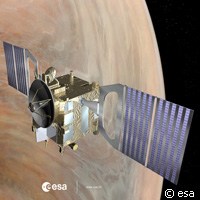ESA says Venus sulphur atmosphere warns against geo-engineering
Despite their differences, Venus has a lot in common with Earth, and we can learn a great deal from our closest planetary neighbour that can prove useful in the future. A case in point is the recent discovery made by the European Space Agency's (ESA) Venus Express of Venus' high-altitude layer of sulphur dioxide. Astronomers have finally cracked the thick cloud layer mystery that has long puzzled scientists. The groundbreaking research is presented in the journal Nature Geoscience. The hothouse planet is shrouded by a sheet of rapidly moving acid clouds that block our view of the surface. The dense clouds scatter back to space around 80% of the light received from the Sun. Scientists translate this phenomenon as Venus having a very high albedo (the fraction of the incident sunlight that is reflected). This is why it's so easy to see with the naked eye, and has long been considered a star rather than a planet. Venus' thick cloud layer forms at about 50 kilometres (km) from the planet's surface, when sulphur dioxide from volcanoes combines with water to form sulphuric acid, one of the most corrosive substances in the natural world. Any remaining sulphur dioxide is rapidly destroyed by solar radiation above 70 km. But a riddle remained: scientists could neither determine why sulphur dioxide was found at 90 km nor where it came from. Computer simulations conducted by Xi Zhang at the California Institute of Technology in the US, together with colleagues from France, Taiwan and the US, showed that sulphuric acid droplets get transported from deep in the atmosphere up to the planet's cloud tops. At high altitude, some of these liquid droplets evaporate, freeing gaseous sulphuric acid that is then broken apart by sunlight, releasing sulphur dioxide gas. 'We had not expected the high-altitude sulphur layer, but now we can explain our measurements,' says Hakan Svedhem, ESA's Venus Express project scientist. 'However, the new findings also mean that the atmospheric sulphur cycle is more complicated than we thought.' The importance it has for our planet is significant, because of the discussed plans of mitigating climate change by injecting Earth's atmosphere with sulphur droplets. Nobel Prize laureate Paul Crutzen of the Max Planck Institute for Chemistry, Germany is one of the people who openly supports injecting sulphur dioxide at 20 km above the Earth to fight climate change caused by carbon dioxide emissions. If the Sun warms the Earth too dangerously, the time may have come to draw the shade, leading scientists suggest. This 'shade' could be a layer of pollution deliberately spewed into the atmosphere to help cool the planet. Dr Crutzen uses the Mount Pinatubo eruption in Philippines as a model for his over-the-top idea. The volcanic eruption in 1991 injected sulphur-bearing particles deep into the stratosphere. The enhanced reflection of solar radiation to space by the particles lowered the Earth's surface temperature by an average of 0.5°C in the year following the eruption. However, Dr Zhang's findings yield a clear warning for us; we must broaden our understanding of the sulphur cycle before even dreaming about using it towards climate goals. An understanding of Venus can eventually lead to a better understanding of our own planet, particularly if we look at the long-term effect of such an experiment on Earth's climate. 'We must study in great detail the potential consequences of such an artificial sulphur layer in the atmosphere of Earth,' points out Jean-Loup Bertaux of the Université de Versailles-Saint-Quentin, France, the principal investigator of the SPICAV (Spectroscopy for Investigation of Characteristics of the Atmosphere of Venus) sensor on Venus Express. 'Venus has an enormous layer of such droplets, so anything that we learn about those clouds is likely to be relevant to any geo-engineering of our own planet.'
Countries
France, Taiwan, United States



